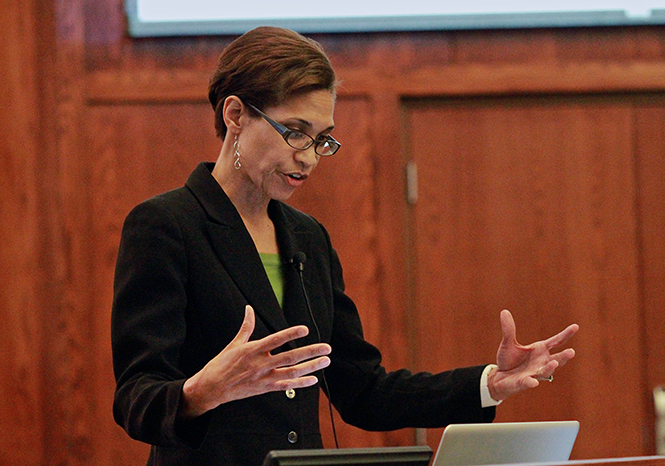Architecture professor explores innovation in inflatables
Dawn Lu
Diane Davis-Sikora speaks about her film “Structure of Air” in the Schwartz Center, Wednesday, April 23, 2014.
April 23, 2014
Diane Davis-Sikora, associate architecture professor, presented a lecture on investigating the ways in which designers can use inflatable structures to address problems involving vacant structures.
“The characteristics of pneumatic structures are really becoming increasingly significant in the ways we can use them,” Davis-Sikora said.
Pneumatic structures are structures made from high-performing textiles and use either air support or air inflation to create space. Air-supported structures have a single membrane system while air-inflated structures have a double membrane. The difference between the two is that the occupant of an air-inflated structure would not be in the pressurized environment, Davis-Sikora said.
Davis-Sikora discussed not only her research regarding inflatables, but also the ways in which she documents such research. Sequential art and documentaries are two types of media she uses to share her research findings, she said.
“My interests in storytelling include sequential art as well as filmmaking and for me the benefits of comic book narrative techniques are that they can start to represent a dynamic way to talk about space and to represent space,” Davis-Sikora said.
Davis-Sikora’s current research proposal suggests a large-scale pneumatic structure that would act as an aeroponic farming system. Aeroponic systems involve growing plants in air without the use of soil, she said.
“The skin of the system is populated with a series of high pressure pneumatic cells — they’re cup like in shape, and each of the cells hold a growing tray,” Davis-Sikora said. “The growing tray is design as a fully-integrated system with irrigation channels woven within it.”
The particular project Davis-Sikora is suggesting would be designed to occupy a large space such as one left vacant by the many Catholic church closures in Cleveland that occurred in 2009, she said.
“It’s conceived of as a stabilization strategy for the neighborhood. Through the use of narrative art, the work is also trying to get at the various ways in which the programming of this repurposing can have and to talk about the future scenarios of use.”
Davis-Sikora also presented her 2013 Rotterdam Architecture Film Festival selection, “Structures of Air.” The 12 minute documentary explores the creation, design and engineering behind pneumatic structures as Davis-Sikora interviewed a variety of individuals throughout Europe during a tour lasting 22 days, she said.
“I have been wanting to see this film since I heard about it here at the beginning of my time here at Kent State,” said William Willoughby, associate dean of the College of Architecture and Environmental Design. “Rotterdam is this place that has a really strong architecture culture.”
Davis-Sikora’s lecture served as the third and final lecture in the College of Architecture and Environmental Design’s spring 2014 “Celebrate CAED” series. She spoke to a small audience of architecture students and faculty members in the Schwartz Center auditorium Wednesday night.
Contact Justin Sheil at [email protected].












